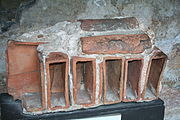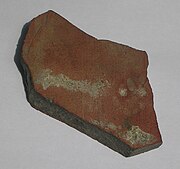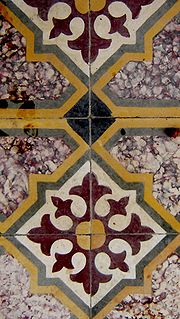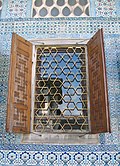
Blue Turkish tiles
A tile is a manufactured piece of hard-wearing material such as ceramic, stone, metal, or even glass. Tiles are generally used for covering roofs, floors, walls, showers, or other objects such as tabletops. Alternatively, tile can sometimes refer to similar units made from lightweight materials such as perlite, wood, and mineral wool, typically used for wall and ceiling applications.
The word is derived from the French word tuile, which is, in turn, from the Latin word tegula, meaning a roof tile composed of baked clay.
Tiles are often used to form wall and floor coverings, and can range from simple square tiles to complex mosaics. Tiles are most often made from ceramic, with a hard glaze finish, but other materials are also commonly used, such as glass, marble, granite, slate, and reformed ceramic slurry, which is cast in a mould and fired.
Roof tiles[]

Roofs with "beaver tail" tiles in Dinkelsbühl, Germany.
Roof tiles are designed mainly to keep out rain, and are traditionally made from locally available materials such as clay or slate. Modern materials such as concrete and plastic are also used and some clay tiles have a waterproof glaze. A large number of shapes (or "profiles") of roof tiles have evolved. These include:
- Flat tiles - the simplest type, which are laid in regular overlapping rows. An example of this is the clay-made "beaver-tail" tile (German Biberschwanz), common in Southern Germany. Flat roof tiles are usually made of clay but also may be made of stone, wood, plastic, concrete, or solar cells.
- Imbrex and tegula, an ancient Roman pattern of curved and flat tiles that make rain channels on a roof.
- Roman tiles - flat in the middle, with a concave curve at one end at a convex curve at the other, to allow interlocking.
- Pantiles - with an S-shaped profile, allowing adjacent tiles to interlock. These result in a ridged pattern resembling a ploughed field. An example of this is the "double Roman" tile, dating from the late 19th century in England and USA.
- Mission or barrel tiles are semi-cylindrical tiles laid in alternating columns of convex and concave tiles. Originally they were made by forming clay around a curved surface, often a log or the maker's thigh. Today barrel tiles are mass produced from clay, metal, concrete or plastic.
Roof tiles are 'hung' from the framework of a roof by fixing them with nails. The tiles are usually hung in parallel rows, with each row overlapping the row below it to exclude rainwater and to cover the nails that hold the row below.
There are also roof tiles for special positions, particularly where the planes of the several pitches meet. They include ridge, hip and valley tiles.
History[]

Ancient Greek roof tiles

Roof fragment of Roman bath in Bath, Somerset, England

Roman roof tile fragment (78mm wide by 97mm high) found in York, UK, with the impression of a kitten's paw.
Fired roof tiles are found as early as the 3rd millennium BC in the Early Helladic House of the tiles in Lerna, Greece.[1] [2] Debris found at the site contained thousands of terracotta tiles having fallen from the roof.[3] In the Mycenaean period, roofs tiles are documented for Gla and Midea.[4]
The earliest finds of roof tiles in archaic Greece are documented from a very restricted area around Corinth]] (Greece), where fired tiles began to replace thatched roofs at two temples of Apollo and Poseidon between 700-650 BC.[5] Spreading rapidly, roof tiles were within fifty years in evidence for a large number of sites around the Eastern Mediterranean, including Mainland Greece, Western Asia Minor, Southern and Central Italy.[6] Early roof tiles showed an S-shape, with the pan and cover tile forming one piece. They were rather bulky affairs, weighing around 30 kg apiece.[7] Being more expensive and labour-intensive to produce than thatch, their introduction has been explained by their greatly enhanced fire resistance which gave desired protection to the costly temples.[8]
The spread of the roof tile technique has to be viewed in connection with the simultaneous rise of monumental architecture in ancient Greece. Only the appearing stone walls, which were replacing the earlier mudbrick and wood walls, were strong enough to support the weight of a tiled roof.[9] As a side-effect, it has been assumed that the new stone and tile construction also ushered in the end of 'Chinese roof' (Knickdach) construction in Greek architecture, as they made the need for an extended roof as rain protection for the mudbrick walls obsolete.[10]
Tiling was extensively used by the Sinhalese kings of ancient Sri Lanka. Mostly they used smoothed and polished stones, which were laid on floors and in swimming pools. Historians suggest that they used advanced techniques and tools for tiling, because each tile fits perfectly to the other, with no gaps. They can still be seen at Ruwanwelisaya and Kuttam Pokuna in the city of Anuradhapura.
One of the great, 20th Century Italian Tile Masters, was Giuseppe Damato, an immigrant from Barletta, Italy who set many masterpieces in the Bay Area.
Floor tiles[]
The elaborate floor pattern of the Sydney Queen Victoria Building

Floor tile in Karpas, northeastern Cyprus
6"x6" porcelain floor tiles
Interior of a high school in the United States covered with tiles
These are commonly made of ceramic or stone, although recent technological advances have resulted in rubber or glass tiles for floors as well. Ceramic tiles may be painted and glazed. Small mosaic tiles may be laid in various patterns. Floor tiles are typically set into mortar consisting of sand, cement and often a latex additive for extra adhesion. The spaces between the tiles are nowadays filled with sanded or unsanded floor grout, but traditionally mortar was used.
Natural stone tiles can be beautiful but as a natural product they are less uniform in color and pattern, and require more planning for use and installation. Mass produced stone tiles are uniform in width and length. Granite or marble tiles are sawn on both sides and then polished or finished on the facing up side, so that they have a uniform thickness. Other natural stone tiles such as slate are typically "riven" (split) on the facing up side so that the thickness of the tile varies slightly from one spot on the tile to another and from one tile to another. Variations in tile thickness can be handled by adjusting the amount of mortar under each part of the tile, by using wide grout lines that "ramp" between different thicknesses, or by using a cold chisel to knock off high spots.
Some stone tiles such as polished granite, marble, and travertine are very slippery when wet. Stone tiles with a riven (split) surface such as slate or with a sawn and then sandblasted or honed surface will be more slip resistant. Ceramic tile for use in wet areas can be made more slip resistant either by using very small tiles so that the grout lines acts as grooves or by imprinting a contour pattern onto the face of the tile.
The hardness of natural stone tiles varies such that some of the softer stone (e.g. limestone) tiles are not suitable for very heavy traffic floor areas. On the other hand, ceramic tiles typically have a glazed upper surface and when that becomes scratched or pitted the floor looks worn, whereas the same amount of wear on natural stone tiles won't show, or will be less noticeable.
Natural stone tiles can be stained by spilled liquids; they must be sealed and periodically resealed with a sealant in contrast to ceramic tiles which only need their grout lines sealed. However, because of the complex, non repeating patterns in natural stone, small amounts of dirt on many natural stone floor tiles do not show.
Most vendors of stone tiles emphasize that there will be variation in color and pattern from one batch of tiles to another of the same description and variation within the same batch.
Stone floor tiles tend to be heavier than ceramic tiles and somewhat more prone to breakage during shipment.

Rubber floor tiles have a variety of uses, both in residential and commercial settings. They are especially useful in situations where it is desired to have high-traction floors or protection for an easily breakable floor. Some common uses include flooring of garage, workshops, patios, swimming pool decks, sport courts, gyms, and dance floors.
Plastic floor tiles including interlocking floor tiles that can be installed without adhesive or glue are a recent innovation and are suitable for areas subject to heavy traffic, wet areas and floors that are subject to movement, damp or contamination from oil, grease or other substances that may prevent adhesion to the substrate. Common uses include old factory floors, garages, gyms and sports complexes, schools and shops.
Medieval letter tiles were used to create Christian inscriptions on church floors.
Decorative tilework and coloured brick[]

Decorative tilework in mosque

Topkapi Palace

Topkapi Palace

Topkapi Palace
Decorative tilework should be distinguished from mosaic, where forms are made of great numbers of tiny irregularly positioned tesserae in a single colour, usually of glass or sometimes ceramic.
The earliest evidence of glazed brick is the discovery of glazed bricks in the Elamite Temple at Chogha Zanbil, dated to the 13th century BCE. Glazed and coloured bricks were used to make low reliefs in Ancient Mesopotamia, most famously the Ishtar Gate of Babylon (ca. 575 BCE), now partly reconstructed in Berlin, with sections elsewhere. Mesopotamian craftsmen were imported for the palaces of the Persian Empire such as Persepolis.
Islamic tiles[]
The Persian tradition continued, and after the Islamic conquest of Persia coloured and often painted glazed bricks or tiles became an important element in Persian architecture, and from there spread to much of the Islamic world, notably the İznik pottery of Turkey under the Ottoman Empire in the 16th and 17th centuries. Palaces, public buildings and mosques were heavily decorated with dense, often massive patterns and friezes of astonishing complexity, including floral motifs and calligraphy as well as geometric patterns. In Safavi era there are quite samples of Persian decorative tile. the capital of Safavis was Isfahan at the time and there are popular mosques, churches, palaces, bazaars and public places decorated with decorative motifs of Persian Tile in that era. Isfahan is still the main city to find this product.
Western tilework[]

Decorative Portuguese wall tiles, after François Boucher's Diana Leaving the Bath, installed 2001
Transmitted via Islamic Spain, a new tradition of Azulejos developed in Spain and especially Portugal, which by the Baroque period produced extremely large painted scenes on tiles, usually in blue and white. Delftware tiles, typically with a painted design covering only one (rather small) tile, were ubiquitous in Holland and widely exported over Northern Europe from the 16th century on. Several 18th century royal palaces had porcelain rooms with the walls entirely covered in porcelain in tiles or panels. Surviving examples include ones at Capodimonte, Naples, the Royal Palace of Madrid and the nearby Royal Palace of Aranjuez.
There are several other types of traditional tiles that remain in manufacture, for example the small, almost mosaic, brightly coloured tiles of Morocco. With exceptions, notably the Porcelain Tower of Nanjing, decorated tiles or glazed bricks do not feature largely in East Asian ceramics.
Portugal and São Luís continue their tradition of azulejo tilework today. In the United States and other Western counties, decorative tiles were in vogue in the 1920s and 1930s. Notable among tilemakers of the period were Ernest A. Batchelder and Pewabic Pottery.
Pebble tile[]
Similar to mosaics or other patterned tiles, pebble tiles are tiles made up of small pebbles attached to a backing. The tile is generally designed in an interlocking pattern so that final installations fit of multiple tiles fit together to have a seamless appearance. A relatively new tile design, pebble tiles were originally developed in Indonesia using pebbles found in various locations in the country. Today, pebble tiles feature all types of stones and pebbles from around the world, but are still generally associated with pebbles found in exotic locations.
Ceiling tiles[]
Ceiling tiles are lightweight tiles used in the interior of buildings. They are placed on a steel grid and they provide thermal but especially sound insulation. They are fabricated from perlite, mineral wool, and fibers from recycled paper. They usually have patterns of holes to improve their sound reflection properties.
Digital tile[]
Printing techniques and digital manipulation of art and photography have converged in custom tile printing. Dye sublimation and the application of ceramic based toners permit printing on a variety of tile types yielding photographic-quality reproduction. Using digital image capture via scanning or digital cameras, bitmap/raster images can be prepared in Photoshop and other photoediting software programs. Specialized custom-tile printing techniques permit transfer under heat and pressure or the use of high temperature kilns to fuse the picture to the tile substrate. This has become an increasingly popular method of producing custom tile murals for kitchens, showers, and commercial decoration in restaurants, hotels, and corporate lobbies.
Mathematics of tiling[]
Certain shapes of tiles, most obviously rectangles, can be replicated to cover a surface with no gaps. These shapes are said to tessellate (from the Latin tessella, 'tile'). For detailed information on tilings see the tessellation page.
Further reading[]
- Marilyn Y. Goldberg, “Greek Temples and Chinese Roofs,” American Journal of Archaeology, Vol. 87, No. 3. (Jul., 1983), pp. 305–310
- Örjan Wikander, “Archaic Roof Tiles the First Generations,” Hesperia, Vol. 59, No. 1. (Jan.–Mar., 1990), pp. 285–290
- William Rostoker; Elizabeth Gebhard, “The Reproduction of Rooftiles for the Archaic Temple of Poseidon at Isthmia, Greece,” Journal of Field Archaeology, Vol. 8, No. 2. (Summer, 1981), pp. 211–227
- Michel Kornmann and CTTB, "Clay bricks and roof tiles, manufacturing and properties", Soc. Industrie Minerale , Paris (2007) ISBN 2-9517765-6-X
See also[]
- Azulejo
- Building integrated photovoltaics
- Dimension stone
- Dropped ceiling
- Encaustic tile
- Glass tiles
- Imbrex and tegula
- Marble
- Mosaic
- Porcelain tile
- Quarry tile
- Roof shingle
- Slate
- Tile mural
- Vitrified tile
References[]
- ↑ Joseph W. Shaw, The Early Helladic II Corridor House: Development and Form, American Journal of Archaeology, Vol. 91, No. 1. (Jan., 1987), pp. 59-79 (59)
- ↑ John C. Overbeck, “Greek Towns of the Early Bronze Age”, The Classical Journal, Vol. 65, No. 1. (Oct., 1969), pp. 1-7 (5)
- ↑ J. L. Caskey, "Lerna in the Early Bronze Age", American Journal of Archaeology, Vol. 72, No. 4. (Oct., 1968), pp. 313-316 (314)
- ↑ Ione Mylonas Shear, “Excavations on the Acropolis of Midea: Results of the Greek-Swedish Excavations under the Direction of Katie Demakopoulou and Paul åström”, American Journal of Archaeology, Vol. 104, No. 1. (Jan., 2000), pp. 133-134
- ↑ Örjan Wikander, p.285
- ↑ Örjan Wikander, p.286
- ↑ William Rostoker; Elizabeth Gebhard, p. 212
- ↑ Örjan Wikander, p.289
- ↑ Marilyn Y. Goldberg, p.309
- ↑ Marilyn Y. Goldberg, p.305
| This article may require cleanup to meet Wikipedia's quality standards. Please improve this article if you can. (April 2008) |
External links[]
| Wikipedia has an article on Tile |
| Look up tile in Wiktionary, the free dictionary. |
| Wikimedia Commons has media related to Tiles that may be added |
This page is being imported from Wikipedia, to create a Wikidwelling stub or article. These steps need to be completed:
The original article was at Tile. The list of authors can be seen in the history for that page. The text of Wikipedia is available under the CC-BY-SA 3.0 license. |
